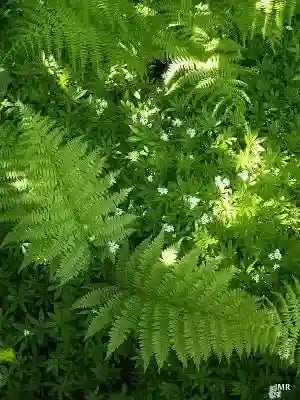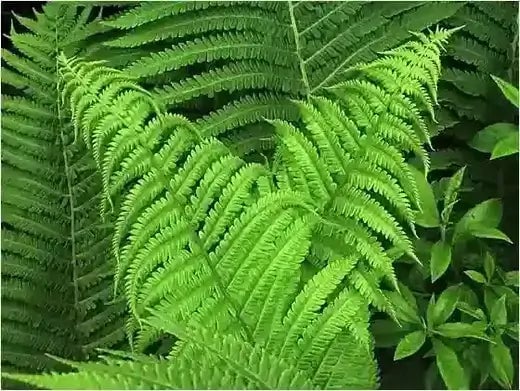Unique Types Of Native Fern
Ferns are usually found in moist, forested regions because they require a lot of water. Ferns thrive throughout all damp areas within New Zealand forests, forming the undergrowth underneath an evergreen canopy that is densely covered with trees. They also grow on branches and trunks of trees and along the banks of streams. Certain hardy species have adapted to urban, alpine, coastal, and desert environments.
Native fern plantsare naturally found in a particular geographic region or ecosystem. These plants have adapted to the specific environmental conditions of their native habitats over time, such as soil type, temperature, moisture levels, and light levels.
There are many different species of fern plants each with its unique characteristics and requirements. Some examples of native ferns in North America include the Maidenhair fern (Adiantum pedatum), the Ostrich fern (Matteuccia struthiopteris), and the Christmas fern (Polystichum acrostichoides).
These ferns play essential roles in their ecosystems, providing habitat for wildlife, stabilizing soil, and contributing to nutrient cycling. They are also used in landscaping and gardening to create beautiful and sustainable landscapes. Here we will explore five unique native ferns for you; stay tuned!
Glade Fern
Glade fern prefers the shade of a full-shaded area. It is more relaxed when you plant it in the shade. But you can maintain it in a semi-shade or filtered sunlight garden, paying close attention to the soil's water and moisture when needed.
The plants are arranged in groups of five or six plants per group in well-drained, moist soil. If they are too dry, the edges of the leaves will change to brown. It signals that it's time for you to provide them with water.
Homalosorus Pycnocarpos's stems are gold brown. It makes a stunning contrast to the bright and shiny green fronds. The plant is characterized by its narrow fronds, which appear to dance an expressive dance with each breeze. The fronds' leaflets are also slim. They sport a slight blade shape with a slight curve, creating a fluttery appearance.
The mature glade fern displays beautiful, long fronds that grow larger than tall. The height is usually between 1 to 2 feet and can reach as high as three feet in width. The small, compact appearance makes the glade fern a great choice to use as a plant that covers the ground.
Glade fern prefers an area that is completely shaded. It is the easiest to care for when placed in the shade. However, it is possible to maintain it in a filtered sun or semi-shade garden, paying immediate care to the soil's water and moisture when needed.
Cinnamon Fern
The cinnamon fern gets its name due to its most distinct feature -- the auburn-colored spikes, which develop when the plant grows. The cinnamon fern is between three to five feet tall and across.
The delicate fronds just beginning to emerge will appear in early spring and then unfold their tender leaves. The ferns will grow larger and taller for some time, producing lively green leaflets that grow in pairs, and possess an edgy edge on the outside.
In the summer, fertile fronds produce spikes
The points will become more prominent as they grow and change to a deep, rich cinnamon hue.
As a native woodland species, it prefers a semi-shady or shaded area in your backyard. They also like more acidic soils, which you may see among some pines in forests.
The Cinnamon Fern is a plant that can be used to fill in empty areas of your yard with minimal watering and care. The ferns are a colony joined by a robust root system. Since they multiply, gardeners can keep them away from stimulating other areas that require an element of green.
Royal Fern
From northern Florida to New England, the Fern is native to North America. While it is found in the wild throughout the Eastern United States, gardeners in the west can quickly cultivate it to delight. Royal Fern grows long, spindly branches covered with green leaves. They grow in clumps as the roots below move across the ground.
Though vast and gorgeous, This Fern is also one of the most difficult to reproduce. The rhizomes of this Fern will slowly move through your yard and sprout new offshoots whenever they please, an appropriate trait for the royal plant.
Royal Fern might be one of the most easy-care plants you can find. The secret to growing this species is to choose the most suitable location. It likes moist to acidic soils but does not like continuous flooding.
Plant it in the shade or in a semi-shaded area to get the most optimal results. It is tolerant to some sun, but it will need irrigation. In a perfect spot, you'll seldom require watering or take care of it. Royal Fern.
Sensitive Fern
Sensitive Fern is a perennial plant, which means it'll return each year. It is sensitive to freezing winter weather. As a result, mulch or another alternative form of protection protects the plants from winter damage. They thrive in moist soil and can be shaded for some shade. This article will cover Fern's delicate plant more in-depth, starting with attributes, growth, and usage.
They thrive in areas with partial sun; they typically require only half a day or more. It is ideal to receive a minimum of six hours of sunshine daily. They do well in moist soil but will not do well in the shade. They are drought-tolerant and do not need a lot of water. If you provide them with water in summer, be sure that they are only given a tiny amount in winter.
Sensitive ferns have two fronds. Fertile fronds have a narrower shape and feature color of trendy apple green, while sterile ones are more elongated with a duller sheen. Fertile fronds are shaped like beads groups on a stem.
They are typically found close to the infertile fronds during the dry time of the year. However, the sterile ones will not be visible during this period. The fronds form a triangular shape. Each leaflet is a beautiful oval shape. The stems of this sensitive plant have a light maroon undertone, which makes the vibrant green shine with a hue.
New York Fern
New York Fern Thelypteris noveboracensis is a beautiful and unique species of Fern indigenous to the United States East Coast. Its distinctive fronds provide a distinctive appearance to any outdoor or indoor space. They are shade-tolerant and low-maintenance, so it's ideal for beginners or experienced gardeners.
It is a perennial plant native to forests in New York state. It has distinct fringes and a triangular blade-like design that is broadest in the middle and narrower at the ends.
The plant's fronds are lance-shaped and have a tip tapering; it can reach up to two feet in width. The leaflets are tiny and are located near the base on the bottom of the front. Upon maturity, the plant can get an average height of two to three feet.
New York ferns can be as giant as one to two feet in maximum size. The leaves on the Fern are small, even when fully mature. The New York fern grows best and is most often seen throughout the United States and Canada along the eastern side. It is a relatively new species of Fern that has been discovered recently.
The Fern is widely believed to belong to the family of plants called Thelypteridaceae. It can grow to maturity and display its most impressive capacity in moist woods worldwide.
Adding mulch to your Fern can allow the plant to flourish and appear its best since ferns thrive better in wet open regions.
The Health Benefits of Native Ferns
The diverse forms and deep-rooted cultural significance of native ferns have led to substantial research interest in their potential health benefits. Many fern species are valued for their decorative appeal, but they also provide medicinal benefits and nutritional value alongside multiple holistic applications. Before flowering plants developed, Ferns established strong survival mechanisms and chemical structures that benefit human health. This section examines how native ferns provide health benefits through medicinal applications and nutritional benefits while supporting a balanced lifestyle.
Before delving into their health benefits, we must understand the different fern species and their traditional applications. Certain fern species remain essential components of conventional diets among indigenous peoples worldwide as they have remained edible throughout history. The culinary use of fiddlehead ferns (young curled fern fronds) extends across North American, Asian, and European cuisines. Fiddleheads receive special recognition because they contain antioxidants and essential minerals, including iron, potassium, and manganese. The minerals found in these ferns help maintain proper blood circulation and cellular functioning. Vitamins A and C found in fiddlehead ferns benefit immune system function, vision maintenance, and skin health support.
Native ferns provide health benefits through their antioxidant properties. Antioxidants eliminate free radicals, which, as unstable molecules, can cause cell damage and accelerate aging and disease development. The antioxidant polyphenols present in multiple fern species help to protect cells from oxidative stress. Native ferns contain antioxidants, which may decrease chronic disease risks like heart disease and certain cancers when eaten with a balanced diet. The protective impact remains limited yet significant, mainly when included in a balanced nutritional regimen.
Ferns possess a notable traditional medicinal background apart from their culinary uses. Fern leaves, alongside stems and spores, have served as remedies for minor wounds and skin issues in multiple locations globally. People in specific communities used fern infusions made by steeping fern leaves or rhizomes in hot water to treat common health problems such as coughs, fevers, and gastrointestinal issues. Research into the medicinal benefits of ferns continues, yet studies show that bioactive compounds found in specific fern species demonstrate antimicrobial and anti-inflammatory properties. Evidence indicates that certain ferns produce substances that inhibit bacterial and fungal growth, which implies they may be helpful for topical treatments.
Proper identification and preparation must be stressed when exploring native ferns' health advantages. While edible fern species exist, there are toxic fern species that should be avoided. According to multiple sources, consuming bracken fern in large amounts or when prepared incorrectly can lead to carcinogenic effects. Anyone looking to add ferns to their diet must seek guidance from trustworthy sources like local agricultural extensions or experienced foragers to confirm the species' edibility and learn how to prepare it safely. Cooking methods like thorough boiling or steaming can lower natural toxic elements while keeping beneficial nutrients intact.
Native ferns provide health advantages beyond direct consumption and medicinal applications because they support well-being through additional subtle means. Horticulture and interior design frequently showcase ferns for their ability to enhance indoor air quality. Many fern species naturally purify the air through their leaves by taking in harmful substances, including formaldehyde, xylene, and benzene. The selection of indoor-appropriate fern species to decorate living spaces helps people achieve improved air quality and a more tranquil environment. Research shows that surrounding ourselves with living plants can help lower stress levels and heighten productivity while improving mental health.
Ferns contribute significantly to ecosystem health because they help maintain soil quality and purify water in forested and wetland areas. Communities' protection of native fern habitats sustains biodiversity and ecological balance, which supports human health across larger areas. The preservation of forests and wetlands results in cleaner water supplies, more substantial pollinator populations, and better carbon storage, creating healthier living conditions for humans.
Ferns' cultural and historical value gives people a deeper connection to nature. Indigenous communities have developed a profound reverence for ferns, which they integrate into their spiritual ceremonies, artistic expressions, and natural medicine practices. Traditional knowledge and sustainable harvesting methods enhance physical health while nurturing emotional and spiritual wellness by promoting a connection to nature.
Native ferns hold multiple benefits that support human health in various ways. Ferns serve as a link to traditional plant knowledge, whether we eat them as fiddleheads packed with nutrients or use them for their antimicrobial properties and place them in our homes to enhance air quality. Ensuring proper identification and preparation and practicing ecological stewardship are essential to enjoy these benefits safely. Acknowledging their natural role, we can explore fresh ways to bring these elegant plants into comprehensive health practices when we show proper respect toward ferns.
Read more

Are you tired of spending countless hours in your garden to keep your plants alive and healthy? If so, it's time to consider adding ferns to your outdoor space. Ferns are an excellent option for th...

Ferns are a favorite option for both indoor and outdoor gardening. They are appreciated for the lush and green foliage and their capacity to succeed in various environments. Like other plants, fern...


